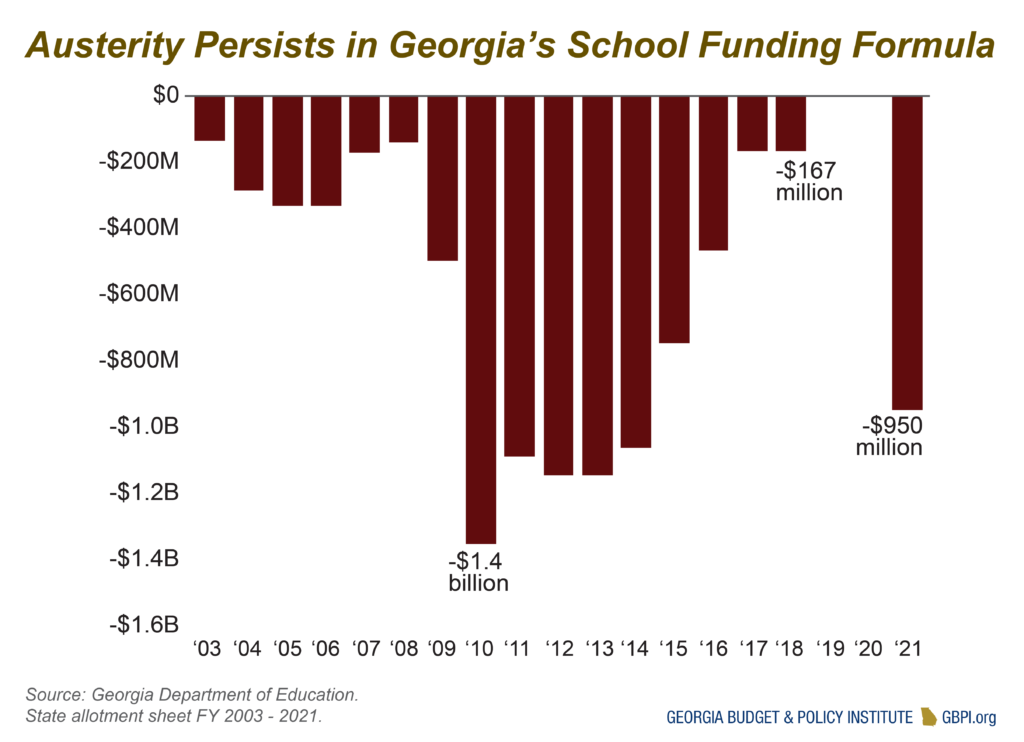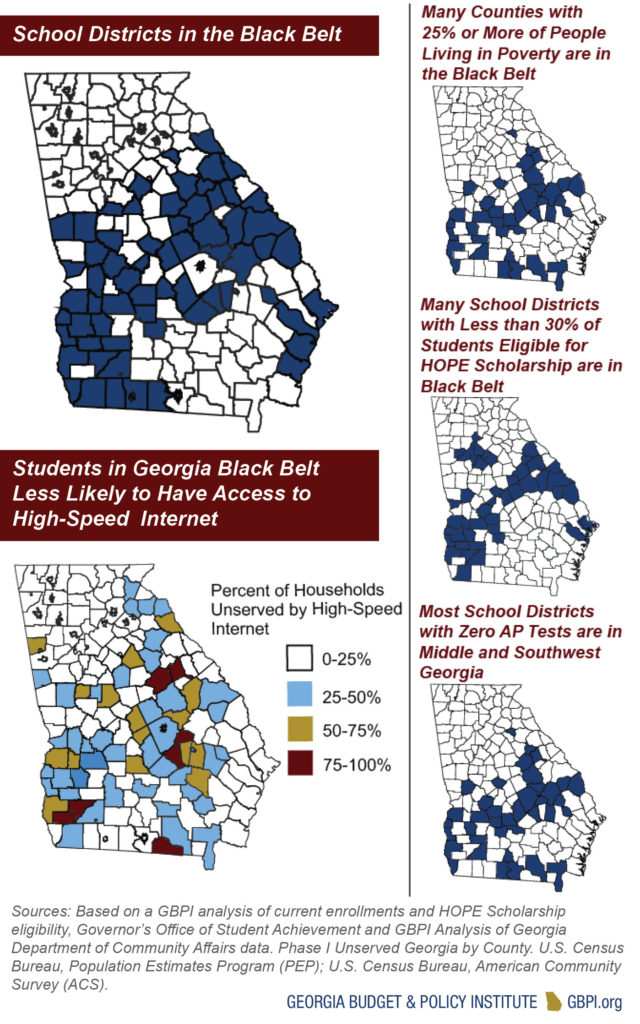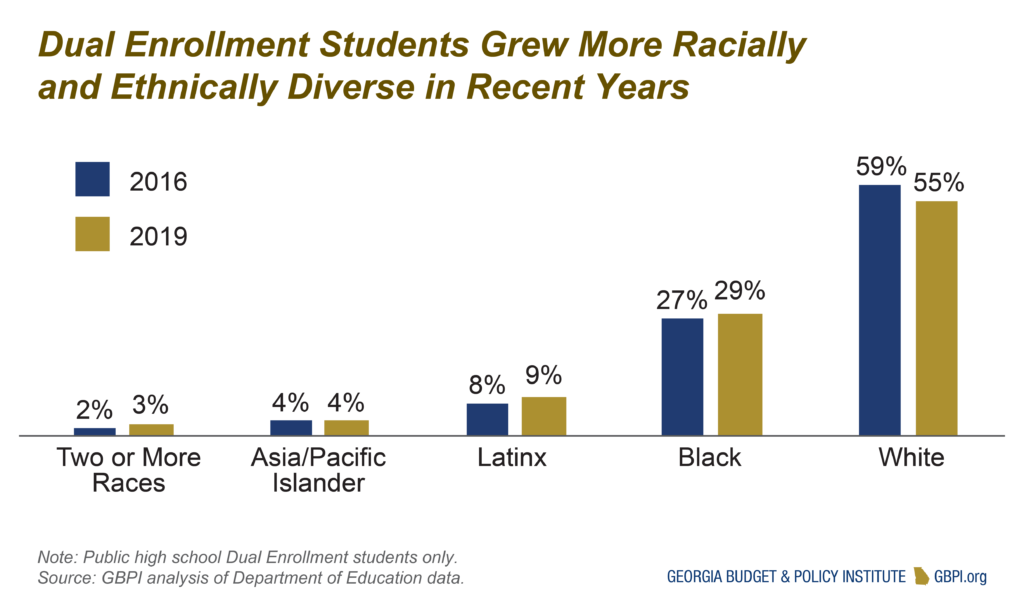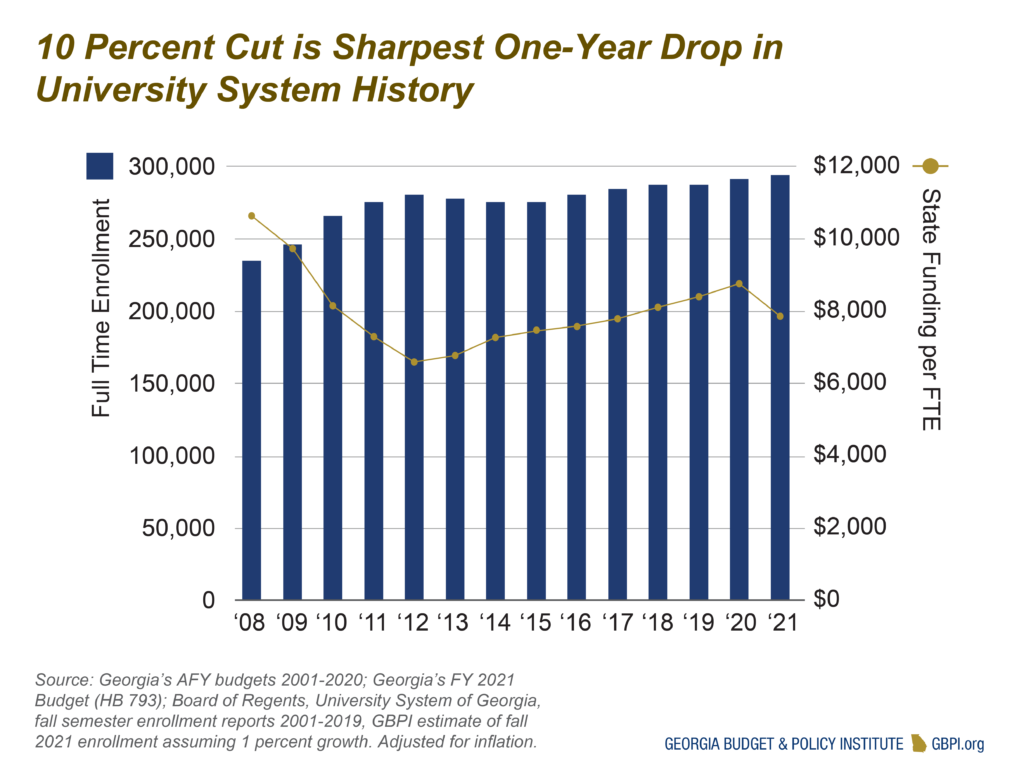Georgia’s 2021 Education Budget
Georgia lawmakers cut $1 billion from the state’s budget for the Department of Education. The bulk of these cuts, totaling $950 million, will be passed on to 181 local K-12 school systems. State support for private school vouchers through tax credits and direct state funding face no budget cuts. Public school leaders will have to grapple with this 10 percent drop in state funding despite significant costs that many will experience as they continue to adapt to COVID-19. The remaining budget for the Department of Education is $9.6 billion for FY 2021.
The 2021 budget also cuts 10 percent from state higher education agencies, resulting in a budget of $2.3 billion for the University System of Georgia and $334 million for the Technical College System of Georgia. The state allocates $126 million in state funds for education programs administered by the Georgia Student Finance Commission, including Dual Enrollment, which pays for high school students to take college courses. Lawmakers cut the 2021 budget for Dual Enrollment by $11 million following passage of legislation creating restrictions on student grade levels and courses.
The Legislature maintained lottery-funded education programs, appropriating $1.4 billion total, including $379 million for pre- Kindergarten and $923 million for HOPE Scholarships, Grants and Student Access Loans. Lottery reserve funds total more than $1.2 billion.
Two Decades, $10.2 Billion Cut from Public Schools
Georgia lawmakers rejected calls to raise revenues during the 2020 General Assembly, resulting in steep cuts to education. The state has only fully funded the Quality Basic Education formula (QBE, which dictates the majority of state education funding) for two of the last 19 years. With the new cuts of $950 million to public education, children that began Kindergarten in FY 2009 will have attended schools that experienced $8.8 billion in cuts before they graduate.
The years following the Great Recession showed that school leaders faced with steep budget cuts were likely to increase class sizes, furlough teachers, shorten the school year and eliminate elective courses. In FY 2021, Georgia’s schools will have less funding for additional costs that promise to arise due to the novel coronavirus, such as cleaning supplies or professional development for teachers facing continued online instruction.
Costs of Schooling During Pandemic Threaten to Leave Georgia’s Black Belt Further Behind
Black Georgians have traditionally received significantly fewer state dollars for public education than their white counterparts. Relatively recent state policies have acted to equalize the funding for schools regardless of the students’ racial makeup. Even with these fiscal policies, however, school districts that are more rural, low-income and have majority-Black student populations face high obstacles to accessing the same educational opportunities as the rest of the state. These districts reside primarily in Georgia’s Black Belt, a swath of Middle and Southwest Georgia where slavery was once concentrated and where many Black Georgians live today. Throughout the pandemic, school district leaders have struggled to plan how to educate children while also keeping the community safe. The lack of availability of high-speed internet leaves many Georgians unable to fully participate in a constitutionally-required free, public education.
Households in Black Belt school districts are twice as likely to lack access to high-speed internet than districts outside the region. More than 13 percent of the households in the Black Belt lack access, while 5.7 percent of households in the rest of the state are in the same position. Black Belt districts are left again with higher obstacles and inadequate state funding to overcome them.
There is no uniform definition of the Black Belt in Georgia or throughout the Southeast. What began as a regional description based on the coloring and fertility of the soil has morphed into a term to generally describe communities in the Southeast with a majority-Black population or where the majority of people live in poverty. GBPI’s analysis considered a school district as part of the Black Belt if they operate in an area that previously had enslaved people greater than 40 percent of the population or if their current student body enrollment exceeded a 30 percent Black population and 30 percent or more of their students were living in poverty.
Transportation Costs Strain Local School Budgets
For FY 2021, the state of Georgia continues a pattern of shortchanging pupil transportation that triggers safety concerns for local school districts. The FY 2021 budget provides $136 million for pupil transportation through QBE. The most recent data available shows that school districts spent $998 million in a single year to bus students to and from the school. Several districts’ plans to safely educate students in the current pandemic would require additional transportation expenditures.
Costs driven by factors such as the price of diesel fuel or the number of students enrolled have increased steadily while state funding has remained flat or decreased during the past two decades. This growth has continued the state trend of reducing its contribution to student transportation funding since 1991, when it covered 54 percent. In FY 2019 the state paid 13 percent of the total cost of pupil transportation.
Pre-Kindergarten Funding Steady and Inadequate
Pre-Kindergarten funding remains steady in FY 2021 due to consistent lottery proceeds during the pandemic. Steady funding, however, is not the same as providing world-class early childhood education. For example, while lead teachers were allotted funding for a $3,000 raise in FY 2020, certified pre-K centers are only provided $16,190 for assistant teachers regardless of the employee’s training or experience. This pay could keep some qualified professionals from seeking those jobs.
Moreover, stagnant funding keeps Georgia’s pre-K program from expanding and providing reimbursements to child care providers for capital improvements such as roof repair or air conditioning. Georgia provides less per student in the program than the state did a decade ago. In FY 2011 Georgia allocated the equivalent of $5,050 per student. When taking inflation into account, that is $352 more than in the current budget cycle.
Dual Enrollment
Dual Enrollment is a program serving more than 50,000 high school students who take college-level courses that count for both high school and college credit. Colleges do not charge high school students, though students may be responsible for course-specific fees and transportation costs.
The 2021 budget cuts $11 million in state funds from Dual Enrollment, resulting in a final budget of $90 million. The Georgia Student Finance Commission, which administers the program, projects that recent policy changes will allow the agency to maintain payments to colleges delivering Dual Enrollment. Originally, the state paid colleges for tuition, mandatory fees and books, as well as funding transportation grants. As participation grew, funding was cut for transportation grants, mandatory fees and books.
Recent Policy Changes to Dual Enrollment Create Estimated $11 Million Reduction:
- 30-credit-hour funding cap for most students
- Core academic courses limited to 11th and 12th graders and some 10th graders with high SAT/ACT scores
- Career, technical and agricultural education (CTAE) course limited to 10th-12th graders
University System of Georgia
The 2021 budget for the university system is $2.3 billion. Georgia allocates $2 billion to colleges and universities for student instruction. Remaining funds go to agricultural services, public libraries and other programs connected to universities. The state appropriates funds to the Board of Regents, which manages the system and allocates money among its 26 schools.
This year’s budget represents a 10 percent cut in state funding: a $261 million reduction overall, including a $233 million reduction to colleges. This cut is the sharpest one-year drop in university system history and eliminates many currently held and vacant faculty and staff positions. The federal CARES Act allocates a total $158 million to Georgia colleges, with restrictions on most funds to address costs related to instructional changes due to the coronavirus pandemic.
Technical College System of Georgia
The 2021 state budget for the technical college system is $334 million. About $298 million is allocated to technical colleges. The rest goes to services administered under the technical college system like Adult Education for those without a high school diploma and customized workforce training for businesses. The budget represents a 10 percent cut, or $36 million less for technical colleges and $4 million in cuts for administration and other programs.
The technical college system includes 22 colleges in Georgia that provide associate degree, certificate and diploma programs. It is also the state’s largest provider of Dual Enrollment courses for high school students. Technical college enrollment often fluctuates with the economy, as people who cannot find work enroll in technical education to learn new skills.
The federal CARES Act provides an additional $37 million for technical colleges, with restrictions on most funds to address costs related to instructional changes due to the coronavirus pandemic.
Lottery Funds: Support for Pre-K and College Students
The 2021 budget cuts administrative costs but maintains awards funding for HOPE scholarships, grants and pre-K classrooms. Georgia appropriated $1.4 billion from lottery sales to fund and administer the following education programs.
HOPE Scholarships: $821 million
- For students pursuing bachelor’s or associate degrees. These funds include the partial-tuition HOPE Scholarship and the full-tuition Zell Miller Scholarship.
HOPE Grants: $66 million
- For students pursuing certificates or diplomas in technical colleges. These funds include the partial- tuition HOPE Grant, full-tuition Zell Miller Grant and supplemental HOPE Career Grant, which covers full tuition for students in specific programs when combined with other HOPE grants.
HOPE GED Grants: $421,667
- One-time awards for students who complete a GED and enroll in postsecondary education.
Student Access Loans: $26 million
- Provide low-interest loans to college students.
Pre-Kindergarten: $379 million
- For 4-year-olds to access high-quality early learning.
More than 170,000 students receive a lottery-funded scholarship, and 5,500 have lottery-funded loans. About 80,000 children enroll in Georgia pre-K; more than 4,000 children are on waiting lists.
Lottery Reserves Protect HOPE and Pre-K
Every year, unspent lottery dollars transfer to reserves managed by the State Treasury. At the end of the 2019 fiscal year, about $79 million in surplus transferred to the lottery reserves.
Since 2011, state law requires the lottery shortfall reserve to hold an amount equal to 50 percent of the previous year’s net lottery proceeds. If lottery ticket sales underperform, the state can draw on this reserve to fund HOPE. After reaching the 50 percent target, additional reserves are considered unrestricted.
GBPI Senior Policy Analyst Dr. Stephen Owens contributed to the K-12 education section of the 2021 Georgia Budget Primer. You can view more of his work here. For more on higher education from Senior Policy Analyst Jennifer Lee, click here.
















